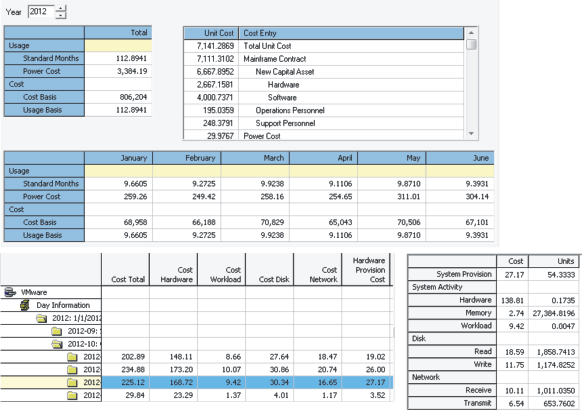Integrated Data
Effective Service Costing
requires the integration of
performance, financial, and
possibly operational data.
Without detailed usage
based performance data, it
is not possible to
effectively identify service
costs.
Resource Inventory
In order to effect service
costing, the processing
must rely on an inventory
of resources that are used
for operational processing.
This inventory represents
the actual datacenters,
systems, and workloads
that are provided as part
of the IT services.
Automated Process
An effective IT Cost
Transparency program is
not a simple process.
Rather it is one that
requires inbuilt knowledge
and the capability to
“blend” different
information from a variety
of sources on a continuous
basis. Effective Service
Costing requires an
automated process that is
designed for the purpose
of IT Cost Transparency.
Workload Based
Service delivery is the ability to deliver a particular service (workload) to the business. To understand
the cost of that service delivery, it is first necessary to understand the processing of the underlying
workload (usage based metering). Once the usage is determined, then it is possible to apply the
applicable unit cost(s) to calculate the cost of the service.
All processing within RG Solutions® is workload based. That is to say, the lowest common value is
a workload (application), and that workload can be isolated to a single system, be part of several
systems, or one of many different workloads on a single system. Through its architecture and user
supplied data formation rules, RG Solutions® makes it possible to view service costs from different
perspectives, groupings, and other business related concerns.
Business Control
While the goal is to identify service costs, nothing will be of value if it is not understood by the
business. A single number cannot be of much value unless it is provided in the context of the
processing. A business consumer needs to know how much was used, when it was used, how it was
used, and other related information in order to become a more responsible consumer of IT services.
The major means for business control of IT services is the standard business practices (i.e.
budgets, forecasts, etc.) along with the introduction of a “Bill of IT”. The Bill of IT can be thought of as
a detailed accounting of the services provided from IT. It should include at a minimum the summary
of usage, unit costs, and the impact of the processing on the consumer’s budget. Detailed information
should be available to the business consumer in the event that analysis is to be performed regarding
behavior, product cost/price, or other related business functions.
Cost Identification
There are two requirements to cost identification within a Cost Transparency program: Determining
the Usage Basis and Determining the Cost Basis. To determine the Usage Basis it is necessary to
calculate the total amount of processing that will be performed during the life of each system or
workload. This type of calculation can be very difficult and complex, but RG Solutions® has the inbuilt
capability to do this function quickly and easily.
The second requirement is to determine the Cost Basis for each system or workload. This
calculation must consider the direct, indirect, and shared costs associated with the processing entity.
The calculation must also be “date aware” in that different cost may apply based on the date of the
associated processing. The net result should be a set of unit prices that will be applied to the incoming
usage values. This is an extremely complex process, but RG Solutions® understands the
requirements and automatically determines the appropriate unit price(s) and applies them to the
corresponding usage values.


